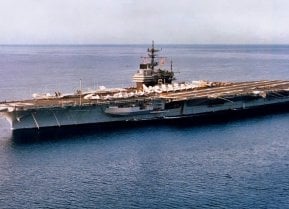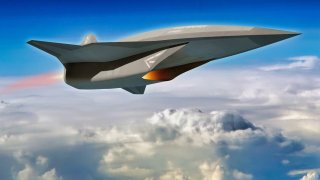Why China Thought Top Gun's Incredible SR-72 Darkstar was Real
Legends of a faster, higher-flying replacement for the SR-71, commonly called the SR-72, first began to emerge back in the 1980s.
IN 2017, LOCKHEED MARTIN SAID THE ENGINE WAS READY TO FLY (AND ACCORDING TO EYEWITNESS REPORTS… ALREADY WAS)
In 2017, Lockheed Martin once again courted media exposure for the SR-72 program with claims that ground testing of its combined-cycle hypersonic engine had been underway since 2013 and the technology was finally mature enough to be placed into a real aircraft.
“We’ve been saying hypersonics is two years away for the last 20 years, but all I can say is the technology is mature and we, along with DARPA and the services, are working hard to get that capability into the hands of our warfighters as soon as possible,” Rob Weiss, Lockheed Martin’s executive vice president and general manager for Skunk Works, told Aviation Week in June 2017.
Weiss claimed the Skunk Works was “getting close” to beginning development of the single-engine full-scale Flight Research Vehicle (FRV) that he also described as about the size of an F-22 Raptor. This single-engine demonstrator was set to start flying by the early 2020s, and Weiss once again affirmed 2030 as the target for a twin-engine platform to enter operational service.
But just a few months later, in September of 2017, eyewitnesses reported seeing a small-scale SR-72 technology demonstrator (or Flight Research Vehicle) flying over Palmdale, California. This is where Lockheed Martin’s Skunk Works Division as well as the Air Force’s classified aircraft manufacturing facility, Plant 42, are located. It is also the same location where Northrop Grumman’s B-21 Raider was spotted making its first test flight just weeks ago.
These reports prompted Aviation Week to reach out to Lockheed Martin’s Orlando Carvalho, executive vice president of aeronautics, at the time. Carvalho was not forthcoming with confirmation but seemed to go out of his way not to deny the eyewitness reports either.
“Although I can’t go into specifics, let us just say the Skunk Works team in Palmdale, California, is doubling down on our commitment to speed,” he told Aviation Week in 2017.
“Hypersonics is like stealth. It is a disruptive technology and will enable various platforms to operate at two to three times the speed of the Blackbird… Security classification guidance will only allow us to say the speed is greater than Mach 5.”
While this statement was meant to offer little in the way of details, it was the first time Lockheed Martin officials seemingly acknowledged that the program may not longer be limiting the SR-72’s intended speed to Mach 6. “Two to three times” the speed of the Blackbird, while potentially just casual hyperbole, would suggest a top speed of Mach 6.4 at least, and potentially as high as Mach 9.6 or higher.
IN EARLY 2018, LOCKHEED MARTIN OFFICIALS SAID THE SR-72 WAS ALREADY FLYING
With rumors swirling about a subscale technology demonstrator already flying with Lockheed Martin and Aerojet Rockeydyne’s combined-cycle engine onboard, Lockheed Martin officials opened 2018 with a hypersonic bang.
In January 2018, Lockheed Martin’s Vice President of Strategy and Customer Requirements in Advanced Development Programs, Jack O’Banion, spoke at the SciTech Forum, held by the American Institute of Aeronautics and Astronautics in Florida. During the event, O’Banion projected an artist’s rendering of the SR-72 and discussed the aircraft as though it already existed and had been seeing successes in testing.
“Without the digital transformation, the aircraft you see there could not have been made,” O’Banion told the audience. “We couldn’t have made the engine itself — it would have melted down into slag if we had tried to produce it five years ago. But now, we can digitally print that engine with an incredibly sophisticated cooling system integral into the material of the engine itself, and have that engine survive for multiple firings for routine operation.”
These statements about the TBCC engine could be attributed to the testing we know Lockheed Martin and Aerojet Rocketdyne conducted between 2013 and 2017, but when pressed about these statements by Bloomberg’s Justin Bachman, O’Bannion doubled down.
“The aircraft is also agile at hypersonic speeds, with reliable engine starts,” he stated unequivocally.
But just two months later, a speech delivered on the opposite side of the world would seemingly thrust the SR-72 effort back into the shadows, where it’s remained ever since.
THE SR-72 PROGRAM SUDDENLY WENT DARK JUST AS THE HYPERSONIC ARMS RACE BEGAN
On March 1, 2018, Russian President Vladimir Putin delivered what has since become an infamous speech, in which he announced what he claimed to be the world’s first operational modern hypersonic weapon, the Kh47M2 Kinzhal, along with Russia’s plans to field the nuclear Avangard hypersonic glide vehicle (HGV). This address has since been seen by many as the onset of the modern hypersonic arms race.
“No one has listened to us,” Putin exclaimed. “You listen to us now.”
Of course, we would later learn that the Kinzhal missile – like the Russian military as a whole – was not nearly as capable as Putin claimed, but at the time, these new weapons seemed to present a serious threat to the United States. And worse still, it was a threat the US had no means to match.
After leading the world in hypersonic technology with programs like NASA’s X-43 and Boeing’s X-51, the US shifted its focus away from advanced systems meant to deter neer-peers throughout two decades of the Global War on Terror. With no publicly disclosed American hypersonic weapons programs in development, let alone in service, Putin’s speech seemed to suggest that America’s old Cold War foe had managed to leapfrog the US in this realm of advanced weapons technology.
And just like that, the SR-72 program disappeared.
Within days of Putin’s speech, as the world’s media exchanged headlines about hypersonic missiles, Lockheed Martin quietly took down the SR-72 webpage that had been up for five years to that point and redirected the URL to its press releases page. All press releases about or even mentioning the SR-72 program were purged from their press release archive.
It was as though the entire effort, which to that point included at least 12 years of work from at least 20 Skunk Works engineers, a partnership with Aerojet Rocketdyne on a propulsion system that underwent at least four years of testing, and what its lead engineer Brad Leland described as “a lot of company money,” just vanished into thin air.
You can now only access Lockheed Martin’s SR-72 page using the Wayback Machine (an internet archive that saves old websites). From March 2018 forward, you will find no mention of the SR-72 anywhere on the entire Lockheed Martin website.
AFTER GOING DARK, HINTS ABOUT THE SR-72 FLIGHT RESEARCH VEHICLE STILL OCCASIONALLY BUBBLED TO THE SURFACE
Despite the SR-72 effort going dark, a video released in 2021 by the Air Force’s Profession of Arms Center of Excellence offered us what may be the first real glimpse of the single-engine SR-72 Flight Research Vehicle Lockheed Martin had previously claimed could be delivered by 2018.
A brief clip of what appears to be an uncrewed demonstrator bearing a striking resemblance to renders of Lockheed’s SR-72 can be seen for a few fleeting seconds near the end of the video. The aircraft does not appear to be CGI-generated, and while it could have been nothing more than an expensive prop, that seems like an unlikely expense for a short clip in a public affairs presentation.
Of course, it also seems odd that the Air Force would reveal such a classified effort in a promotional video, but based on Muradian’s comments we already discussed, the program needed to be re-scoped after the delivery of the first test articles.
Revealing this brief snippet of the SR-72 FRV (if that is, indeed what is seen in the video) could have been meant as a winking message to national adversary nations already fielding hypersonic weapons the United States publicly had no means to match. Or, if the program was in question before being re-scoped, the brief reveal may have been seen as a minimal security risk.
If real, this brief clip shows the effort was ongoing, or at the very least, had resulted in delivered test articles by 2021.
CHINA ALLEGEDLY THOUGHT TOP GUN’S DARKSTAR WAS REAL… DID THEY HAVE A GOOD REASON?
In 2022, Top Gun: Maverick flew into theaters with an unusual new aircraft in tow – an experimental hypersonic technology demonstrator powered by a turbine-based combined cycle engine designed and built by Lockheed Martin’s Skunk Works.
And that’s not just a line in the script – it’s reality.
“The reason it looks so real is because it was the engineers from Skunk Works who helped us design it,” the film’s director, Joseph Kosinki told Sandboxx News before the movie’s opening. “So those are the same people who are working on real aircraft who helped us design Darkstar for this film.”
The resulting Skunk Works mock-up was so realistic, producer Jerry Bruckheimer told us, that it allegedly even managed to fool China’s intelligence apparatus.
“The Navy told us that a Chinese satellite turned and headed on a different route to photograph that plane. They thought it was real. That’s how real it looks,” Bruckheimer first told Sandboxx News.


